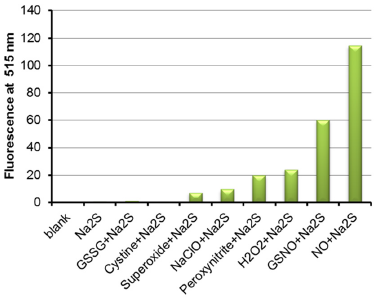General Information
It becomes obvious that there are a lots of molecules containing sulfane sulfurs such as persulfides and polysulfi des in living body. These molecular species are involved in production, storage and release of hydrogen sulfide, which is recognized as an important physiological mediator. Furthermore, recent studies reveal that persulfi des and polysulfi des may control intracellular signal transduction through s-sulfhydration of proteins.
SSP4 (Sulfane Sulfur Probe 4) is a novel fl uorescent probe to detect sulfane sulfurs selectively. SSP4 itself is non-fluorescent, but it emits strong green fl uorescence when it reacts with sulfane sulfurs. Thus, SSP4 enables high sensitive fl uorescence detection and imaging of sulfane sulfurs.

Fig. 1 Reaction of SSP4 with sulfane sulfurs
-
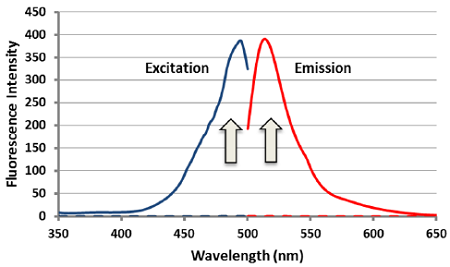
Fig. 2 Excitation and emission spectra of SSP4 after reaction with sulfane sulfurs- Sodium trisulfide (Na2S3) was added to SSP4 in PBS.
λex=482 nm, λem=515 nm
- Sodium trisulfide (Na2S3) was added to SSP4 in PBS.
-
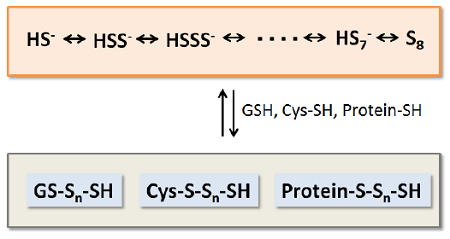
Fig. 3 Chemical species containing sulfane sulfurs
Contents
| SSP4 | 1 mg x 1 |
Storage Conditions
Store at -20 °C and protect from light
Required Equipment and Materials
- Dimethyl sulfoxide (DMSO)
- Serum-free medium
- PBS
- Micropipettes
Preparation of Solutions
- 10 mmol/l SSP 4 Stock Solution
Add 165 μl of DMSO to a tube containing 1 mg of SSP4 and dissolve by pipetting.
- Store at -20 °C and use within two months. Aliquot the solution for longer storage.
- Serum-free Medium containing 0.5 mmol/l CTAB
Add 1 ml of ddH2O to 36.4 mg of CTAB in a 1.5 ml-tube, and dissolve by heating to prepare 100 mmol/l CTAB solution. Dilute this solution with a serum-free medium to prepare a serum-free medium containing 0.5 mmol/l CTAB.
- We recommend to use CTAB for introduction of SSP4 into cells.
- SSP4 Working Solution
Dilute 10 mmol/l SSP4 Stock Solution with a Serum-free Medium containing 0.5 mmol/l CTAB to prepare 5-20
μmol/l SSP4 Working Solution.- To prepare 20 μmol/l SSP4 Working Solution, add 10 μl of 10 mmol/l SSP4 Stock Solution to 5 ml of a Serum-free Medium containing 0.5 mmol/l CTAB.
General Protocol
Fluorescence imaging of sulfane sulfurs in cells
- Culture cells in a plate or dish applicable for fluorescence imaging.
- Discard the culture medium and wash the cells with a serum-free medium.
- Add SSP4 Working Solution to the cells, incubate for 15 minutes in a humidified incubator (e.g., at 37°C, 5% CO2).
- Discard the supernatant, wash the cells with PBS twice.
- Add PBS to the cells, analyze the cells under a fl uorescence microscope.
Experimental Example 1
Detection of sulfane sulfurs in cells treated with a sulfane sulfur donor or sulfane sulfur quencher
- CHO cell suspensions prepared with serum-containing DMEM were inoculated in a 96-well black clear bottom plate to prepare 104 cells/well, and incubated in a humidifi ed incubator (e.g., at 37°C, 5% CO2) overnight.
- The culture medium was discarded, and the cells were washed with a serum-free DMEM.
- 100 μl of a 100 μmol/l Na2S3 or 1 mmol/l NaCN (serum-free DMEM) was added to the each well, and the cells were incubated for 15 minutes in the incubator.
- The supernatant was discarded, and the cells were washded with a serum-free DMEM twice.
- 100 μl of a 20 μmol/l SSP4 Working Solution was added to the cells, and the cells were incubated for 15minutes in the incubator.
- The supernatant was discarded, and the cells were washed with PBS twice.
- 100 μl of PBS was added to the each wells, and the cells were analyzed under a fl uorescence microscope.
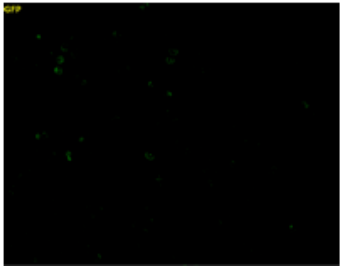 Control Cells |
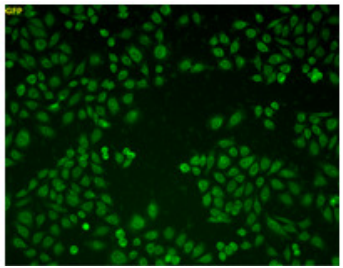 100 μmol/l Na2S3 treated Cells |
| (Exporsue time: 1000 msec) | |
Fluorescence signals were observed in cells treated with 100 μmol/l Na2S3 (sulfane sulfur donor).
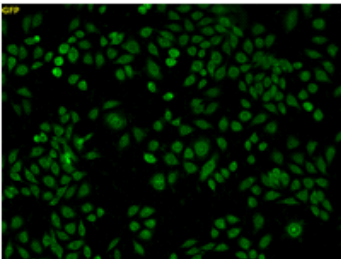 Control Cells |
 1 mmol/l NaCN treated Cells |
| (Exporsue time: 2000 msec) | |
No fl uorescence signals were observed in cells treated with 1 mmol/l NaCN (sufane sulfur quencher).
Fig. 4 Fluorescence images of sulfane sulfurs in cells treated with Na2S3 or NaCN
Experimental Example 2
Detection of sulfane sulfurs produced by reactions between hydrogen sulfi de and reactive oxygen (or nitrogen) species
-
- 100 μmol/l Na2S and 100 μmol/l reactive oxygen (or nitrogen) species were mixed in PBS, and incubated at room temperature for 10 minutes.
- 10 mmol/l SSP4 Stock Solution was added to the reaction mixture (SSP4 fi nal conc.:10 μmol/l) , and incubated at room temperature for 30 minutes.
- The fl uorescence intensities were measured at 515 nm
(λex=482 nm) with a fl uorophotometer.
Chemical species containing sulfane sulfurs were produced by these reactions. Especially, the reaction between hydrogen sulfi de (H2S) and nitric oxide (NO) gave the highest generation effi ciency of sulfane sulfurs.
References
- W. Chen, C. Liu, B. Peng, Y. Zhao, A. Pacheco and M. Xian, Chem. Sci., 2013, 4, 2892.
- T. Ida, T. Sawa, H. Ihara. Y. Tsuchiya, Y. Watanabe, Y. Kumagai, M. Suematsu, H. Motohashi, S. Fujii, T. Matsunaga, M. Yamamoto, K. Ono, N. O. Devarie-Baez, M. Xian, J. M Fukuto, and T. Akaike, Proc. Natl. Acad. Sci. USA., 2014, 111, 7606.
- E. Marutani, M. Sakaguchi, W. Chen, K. Sasakura, J. Liu, M. Xian, K. Hanaoka, T. Nagano, and F. Ichinose, Med. Chem. Commun., 2014, 5, 1577.
- M. Sakaguchi, E. Marutani, H-S. Shin, W. Chen, K. Hanaoka, M. Xian, and F. Ichinose, Anesthesiology. 2014, 121, 1248.
Frequently Asked Questions / Reference
SB10: -SulfoBiotics- SSP4
Revised Aug., 31, 2023


 Hidden sections will not be printed.
Hidden sections will not be printed.